Penang Island: Difference between revisions
→Economy: added an economy section Tags: nowiki added Visual edit |
→Economy: added a section for architecture Tags: nowiki added Visual edit |
||
| Line 35: | Line 35: | ||
| established_title2 = [[British crown colony]] |
| established_title2 = [[British crown colony]] |
||
| established_date2 = 1 April 1867 |
| established_date2 = 1 April 1867 |
||
| established_title3 = |
| established_title3 = Granted city status |
||
| established_date3 = |
| established_date3 = 1 January 2015 |
||
| established_title4 = Granted city status |
|||
| established_date4 = 1 January 2015 |
|||
| leader_title = Mayor |
| leader_title = Mayor |
||
| leader_name = Patahiyah Ismail |
| leader_name = Patahiyah Ismail |
||
| Line 55: | Line 53: | ||
| website = {{URL|mbpp.gov.my/}} |
| website = {{URL|mbpp.gov.my/}} |
||
| footnotes = |
| footnotes = |
||
| translit_lang1_type1 = [[ |
| translit_lang1_type1 = [[Simplified Chinese character|Chinese]] |
||
| translit_lang1_info1 = |
| translit_lang1_info1 = 檳榔嶼 |
||
| translit_lang1_type2 = [[ |
| translit_lang1_type2 = [[Malay language|Malay]] |
||
| translit_lang1_info2 = {{script/Arabic|ڤولاو ڤينڠ}} |
| translit_lang1_info2 = Pulau Pinang ({{script/Arabic|ڤولاو ڤينڠ}}) |
||
| translit_lang1_type3 = [[ |
| translit_lang1_type3 = [[Malaysian Tamil|Tamil]] |
||
| translit_lang1_info3 = |
| translit_lang1_info3 = பினாங்கு தீவு |
||
| translit_lang1_type4 = [[Malaysian Tamil|Tamil]] |
|||
| translit_lang1_info4 = பினாங்கு தீவு |
|||
| coordinates_region = MY |
| coordinates_region = MY |
||
| timezone = [[Malaysian Standard Time|MST]] |
| timezone = [[Malaysian Standard Time|MST]] |
||
| Line 497: | Line 493: | ||
This [[entrepôt]] trade has now greatly declined, due in part to the loss of [[George Town, Penang|George Town]]'s free-port status and to the active development of [[Port Klang]] near [[Kuala Lumpur]].<ref name=":52">http://profile.nus.edu.sg/fass/socgohd/trans_2.1.pdf</ref><ref name=":132">{{Cite book|title=Kuala Lumpur, Melaka and Penang|last=Brash|first=Celeste|publisher=Lonely Planet|year=2008|isbn=9781741044850|location=|pages=|via=}}</ref><ref name=":142">{{Cite news|url=http://www.nytimes.com/2010/12/05/travel/05georgetown-nextstop.html|title=In Malaysia, Tourists Are Lured by George Town's Colorful Past|last=Eckhardt|first=Robyn|date=2 December 2010|newspaper=The New York Times|issn=0362-4331|access-date=16 October 2016}}</ref> However, the Port of Penang still serves as the major harbour within the northern region of [[Malaysia]]. As of 2010, the Port of Penang handled over 1.1 million TEU of cargo, the second highest amount in [[Malaysia]].<ref name=":15" /> |
This [[entrepôt]] trade has now greatly declined, due in part to the loss of [[George Town, Penang|George Town]]'s free-port status and to the active development of [[Port Klang]] near [[Kuala Lumpur]].<ref name=":52">http://profile.nus.edu.sg/fass/socgohd/trans_2.1.pdf</ref><ref name=":132">{{Cite book|title=Kuala Lumpur, Melaka and Penang|last=Brash|first=Celeste|publisher=Lonely Planet|year=2008|isbn=9781741044850|location=|pages=|via=}}</ref><ref name=":142">{{Cite news|url=http://www.nytimes.com/2010/12/05/travel/05georgetown-nextstop.html|title=In Malaysia, Tourists Are Lured by George Town's Colorful Past|last=Eckhardt|first=Robyn|date=2 December 2010|newspaper=The New York Times|issn=0362-4331|access-date=16 October 2016}}</ref> However, the Port of Penang still serves as the major harbour within the northern region of [[Malaysia]]. As of 2010, the Port of Penang handled over 1.1 million TEU of cargo, the second highest amount in [[Malaysia]].<ref name=":15" /> |
||
== Architecture == |
|||
{{Main article|Architecture of Penang}}Centuries of development have brought a mix of architectural styles to Penang Island, both historical and modern. The centre of [[George Town, Penang|George Town]] has been inscribed as a [[UNESCO]] [[World Heritage Site]] due to its '''unique architectural and cultural townscape without parallel anywhere in East and [[Southeast Asia]]''<nowiki/>'.<ref name=":7" /><ref name=":17" /> Just outside the [[UNESCO]] zone lies the modern cityscape, with skyscrapers, residential high-rises, office blocks and shopping malls built all over the island city.[[File:Eastern & Oriental Hotel Penang Dec 2006 003.jpg|thumb|[[Eastern & Oriental Hotel]], opened in 1885, also features colonial architecture.]] |
|||
[[File:Victoria Clock Tower Penang Dec 2006 003.jpg|left|thumb|The [[Moorish architecture|Moorish]]-style [[Jubilee Clock Tower|Queen Victoria Memorial Clock Tower]] is among the most prominent clock towers in the city.]] |
|||
In particular, the older architecture reflects the legacy of 171 years of [[British Empire|British]] rule, coalescing [[Malay Architecture|Malay]], [[Chinese architecture|Chinese]], [[Indian architecture|Indian]], [[Peranakan]], [[Siamese Architecture|Siamese]], Burmese and other cultural influences. This blend of architectural styles is also ubiquitous in [[Malacca City|Malacca]] and [[Singapore]], two fellow [[Straits Settlements]] which shared similar [[British Empire|British]] colonial legacies. However, unlike [[Singapore]], where many heritage buildings have been replaced by modern [[skyscrapers]] and [[Housing and Development Board|high-rise apartments]], [[George Town, Penang|George Town]]'s architectural heritage has enjoyed a better fate. Since the 2000s, conservation efforts have brought previously derelict heritage buildings such as the famous [[Cheong Fatt Tze Mansion]] back to life.<ref>{{Cite news|url=http://www.cheongfatttzemansion.com/about-the-mansion/history/|title=History {{!}} Cheong Fatt Tze's Blue Mansion Hotel in Penang|newspaper=Cheong Fatt Tze - The Blue Mansion|language=en-US|access-date=17 October 2016}}</ref> |
|||
[[File:Mahamariamman Temple Penang Dec 2006 001.jpg|left|thumb|[[Sri Mahamariamman Temple, Penang|Sri Mahamariamman Temple]], with a history dating back to 1801, is the focal point of [[George Town, Penang|George Town]]'s [[Little India, Penang|Little India]].]] |
|||
=== Historical Architecture === |
|||
Most of [[George Town, Penang|George Town]]'s famous heritage landmarks are located within its [[UNESCO]] [[World Heritage Site]]. One of the first structures to be constructed in [[George Town, Penang|George Town]] was [[Fort Cornwallis]], which was built just weeks after Captain [[Francis Light]] had first landed in 1786.<ref name=":16" /> |
|||
[[File:Kapitan Keling.JPG|thumb|[[Kapitan Keling Mosque]] was built by Indian Muslims in the early 1800s, one of the first in the city.]] |
|||
[[File:Penang Malaysia Wat-Chaiya-Mangkalaram-Temple-01.jpg|thumb|[[Wat Chayamangkalaram]] at [[Pulau Tikus]] was constructed in 1845 by the Thai community in [[George Town, Penang|George Town]].]] |
|||
The governmental buildings in [[George Town, Penang|George Town]] were built in various colonial architectural styles. For example, the [[City Hall, Penang|City Hall]] was built in the [[Edwardian architecture|Edwardian]] [[Baroque architecture|Baroque]] style, whereas the Supreme Court features a [[Palladian architecture|Palladian]] architectural style, similar to that of [[St. George's Church, Penang|St. George's Church]].<ref>{{Cite news|url=http://www.penang-traveltips.com/supreme-court.htm|title=Penang Supreme Court Building, George Town, Penang / Pulau Pinang|access-date=17 October 2016}}</ref> The [[Eastern & Oriental Hotel]] is a sibling of [[Singapore]]'s [[Raffles Hotel]]; both were founded by the [[Sarkies Brothers]] and built in colonial architecture. |
|||
[[File:Kek Lok Si Temple.jpg|left|thumb|[[Kek Lok Si]], with its main pagoda incorporating [[Chinese architecture|Chinese]], Burmese and [[Siamese Architecture|Siamese]] influences, is a major tourist attraction at [[Air Itam]].]] |
|||
Many of the bank headquarters along [[Beach Street, George Town|Beach Street]], such as [[Standard Chartered Bank]] and [[HSBC]] were also constructed in the [[Art Deco]] styles.<ref>{{Cite news|url=http://www.penang-traveltips.com/standard-chartered-building.htm|title=Standard Chartered Bank, George Town, Penang / Pulau Pinang|access-date=17 October 2016}}</ref><ref>{{Cite web|url=http://www.mypenang.gov.my/itemprint.aspx?id=1649|title=myPenang - HSBC Building|website=www.mypenang.gov.my|access-date=17 October 2016}}</ref> |
|||
In addition, various Asian architectural styles can be seen throughout the [[UNESCO]] [[World Heritage Site]], some of them combining different cultural influences. [[Kapitan Keling Mosque]], the largest mosque within the zone, combines [[Moorish architecture|Moorish]], [[Mughal architecture|Mughal]] and [[Islamic architecture|Islamic]] styles. [[Cheong Fatt Tze Mansion]] and the Pinang Peranakan Mansion both merge [[Chinese architecture|Chinese]] architecture and [[European architecture and art|European]] interior design, while the [[Sun Yat-sen Museum Penang|Sun Yat-sen Museum]] is one of the countless examples of a typical [[Peranakan]] townhouse which dominates the cityscape.<ref>{{Cite web|url=http://www.pinangperanakanmansion.com.my/|title=Pinang Peranakan Mansion Home Page|website=www.pinangperanakanmansion.com.my|access-date=17 October 2016}}</ref><ref>{{Cite web|url=http://www.hbp.usm.my/conservation/SeminarPaper/peranakan%20cina.html|title=THE ARCHITECTURAL STYLE OF THE PERANAKAN CINA|website=www.hbp.usm.my|access-date=17 October 2016}}</ref> Other unique examples of [[Chinese architecture|Chinese]] architecture include [[Khoo Kongsi]] and the Clan Jetties. [[Little India, Penang|Little India]] contains more Hindu and Indian Muslim architecture, such as the [[Sri Mahamariamman Temple, Penang|Sri Mahamariamman Temple]] and the Nagore Durgha Shrine. |
|||
Impressive heritage architecture outside the [[UNESCO]] [[World Heritage Site]] includes the colonial bungalows built by ''[[nouveau riche]]'' Chinese tycoons in the 19th century along Northam Road (now Jalan Sultan Ahmad Shah), and stately bungalows like [[The Residency, Penang|The Residency]] and [[Suffolk House, Penang|Suffolk House]]. |
|||
The Thai and Burmese communities have left their mark on [[George Town, Penang|George Town]]'s landscape. At [[Pulau Tikus]], [[Wat Chayamangkalaram]] is a Thai temple that is famous for its [[reclining Buddha]] statue, while [[Dhammikarama Burmese Temple]] is located nearby. [[Kek Lok Si Temple|Kek Lok Si]], situated at [[Air Itam]] was completed in the 1930s, merging [[Chinese architecture|Chinese]], [[Architecture of Thailand|Siamese]] and Burmese architectural styles into its main pagoda.[[File:Penang komtar jetty butterworth.jpg|thumb|[[Komtar|Komtar Tower]], the tallest skyscraper in [[Penang]], forms an imposing backdrop of [[George Town, Penang|George Town]].]] |
|||
=== Modern Architecture === |
|||
Since the mid 20th century, modern urbanisation has transformed much of Penang Island. Skyscrapers and high-rises have sprung up all over the city, sometimes side-by-side with heritage buildings. Industrial estates are concentrated within [[Bayan Lepas]] to the south. |
|||
[[File:Penang Hill View.jpg|left|thumb|High-rises at [[Jelutong (federal constituency)|Jelutong]], [[Gelugor]] and [[Air Itam]] can be seen in this picture taken from [[Penang Hill]], the highest point of Penang Island.]] |
|||
Just south of the [[UNESCO]] [[World Heritage Site]] stands [[Komtar]], the tallest skyscraper in [[Penang]] at nearly 250 meters tall. It forms the core of [[George Town, Penang|George Town]]'s modern centre, surrounded by residential high-rises like Hotel Jen, St. Giles Wembley Hotel, Neo+ Hotel and Penang Times Square, as well as shopping centres including Prangin Mall, [[1st Avenue Mall|1st. Avenue]] and Gama. |
|||
Skyscrapers and high-rises have also been constructed along [[George Town, Penang|George Town]]'s northern shoreline from Northam Road (now Jalan Sultan Ahmad Shah) to [[Gurney Drive]]. Notably, the East and West Towers of [[Gurney Paragon]], at 155 metres tall, are the second tallest skyscrapers in [[Penang]]. |
|||
With increasing urbanisation, high-rises are also springing up throughout Penang Island. |
|||
==Notes== |
==Notes== |
||
Revision as of 09:00, 21 October 2016
This article or section is in a state of significant expansion or restructuring. You are welcome to assist in its construction by editing it as well. If this article or section has not been edited in several days, please remove this template. If you are the editor who added this template and you are actively editing, please be sure to replace this template with {{in use}} during the active editing session. Click on the link for template parameters to use.
This article was last edited by Vnonymous (talk | contribs) 7 years ago. (Update timer) |
Penang Island | |
|---|---|
| Other transcription(s) | |
| • Chinese | 檳榔嶼 |
| • Malay | Pulau Pinang (ڤولاو ڤينڠ) |
| • Tamil | பினாங்கு தீவு |
 Clockwise from top : George Town, its suburb of Tanjung Bungah, the UNESCO World Heritage Site, Queensbay Mall in Bayan Lepas and Balik Pulau. | |
| Nickname(s): Pulau Mutiara Pearl of the Orient[1] | |
 Location of Penang Island in Peninsular Malaysia. | |
| Country | |
| State | |
| Founded by the British | 17 July 1786 |
| British crown colony | 1 April 1867 |
| Granted city status | 1 January 2015 |
| Government | |
| • Mayor | Patahiyah Ismail |
| Area | |
| • Island City | 293 km2 (113 sq mi) |
| • Metro | 2,740.000 km2 (1,057.920 sq mi) |
| Elevation | 735 m (2,411 ft) |
| Population (2010) | |
| • Island City | 708,000[3] |
| • Metro | 2.5 million |
| Time zone | UTC+8 (MST) |
| • Summer (DST) | Not observed |
| Postal code | 100xx to 119xx |
| Area code(s) | +604 |
| Vehicle registration | P |
| Website | mbpp |
Penang Island, the most populous island city in Malaysia, is situated in the state of Penang. With a population of 738,500, it is the second largest city in Malaysia by population, while the Greater Penang conurbation with 2.5 million inhabitants is the nation's second most populous metropolis.[5] Its capital, George Town, is one of the oldest cities in Malaysia and has been inscribed as a UNESCO World Heritage Site since 2008.
Founded by Captain Francis Light of the British East India Company in 1786, Penang Island, then named the Prince of Wales Island, was among the first British possessions in South-east Asia. Together with Singapore and Malacca, the island was governed under the Straits Settlements, which became a British crown colony in 1867. The island was subjugated by the Empire of Japan during World War II, before being recaptured by the British at war's end. Shortly before Malaya gained independence from the British in 1957, George Town was declared a city by Queen Elizabeth II, the first in the country's modern history. Penang Island has also developed into the 'Silicon Valley of the East' since the 1970s, and the entire island was granted city status in 2015.
Under British rule, Penang Island had grown into an entrepôt and a centre of spice production in Southeast Asia. This attracted various religions and ethnicities, including the Peranakans, onto its shores; the resulting mix of cultures, architectural styles, cuisine and languages led to the inscription of George Town as a UNESCO World Heritage Site in 2008 along with Malacca City.[6] In addition, George Town was also ranked as Malaysia's most liveable city and the eighth most liveable city in Asia by ECA International in 2010.[7][8][9]
More recently, the island has become one of the most important economic powerhouses in Malaysia, with Bayan Lepas a major manufacturing centre with several multi-national firms and George Town serving as the nation's medical tourism hub.[10][11][12] Furthermore, Penang Island is the financial centre of northern Malaysia, with numerous international banks based in George Town.
Logistically, Penang Island is well-connected. The Penang International Airport is one of the busiest in Malaysia, with links to major regional cities such as Kuala Lumpur, Singapore, Bangkok, Taipei and Hong Kong. The Port of Penang still serves as the main harbour within the north of Malaysia, with connections to over 200 ports worldwide.[13][14] Penang Island is connected to the rest of Peninsular Malaysia by the Penang Bridge, the Second Penang Bridge and a ferry service.
Etymology
The state of Penang is named after Penang Island, which was, in turn, named after the areca nut palm (Areca catechu, family: Palmae), which translates as Pinang in Malay.[15] To this day, the island has also been known as the Pearl of the Orient, or Pulau Mutiara in Malay.
The early Malays called the island Pulau Ka-Satu (First Island) because it was the largest island encountered on the trading sea-route between Lingga and Kedah.[16] The Siamese, then the overlord of the Kedah Sultanate, referred to the island as Koh Maak (Thai: เกาะหมาก), meaning areca nut palm island.[17][18] In the 15th century, the island was referred to as Bīnláng Yù (simplified Chinese: 槟榔屿; traditional Chinese: 檳榔嶼) in the navigational drawings used by Admiral Zheng He of Ming China.[17][19] The 16th-century Portuguese historian Emanuel Godinho de Eredia also referred to the island as Pulo Pinaom.[20]
Malaysia has another smaller island named Pulau Pinang which is located off Johor's South China Sea coast.[21]
History
Founding of Penang Island
Penang Island was discovered as early as the 15th century, when Chinese sailors under Admiral Zheng He mapped the island as Bīnláng Yù (simplified Chinese: 槟榔屿; traditional Chinese: 檳榔嶼) in the 'Nautical Charts of Zheng He'. At the time, Ming China was launching naval expeditions that would eventually sail all the way to Africa.
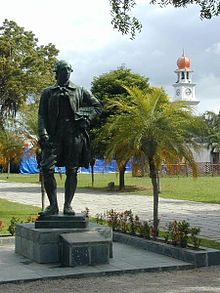
The first Englishman to reach Penang Island was actually Sir James Lancaster, a navigator and privateer who commanded the Edward Bonadventure. He landed at Batu Ferringhi in June 1592 and remained on the island until September, pillaging every vessel he encountered. He only sailed home to England in May 1594.[22]
In the early 18th century, ethnic Minangkabaus from Sumatra opened up a settlement on Penang Island. Haji Muhammad Salleh, known as Nakhoda Intan, anchored in Batu Uban and built Masjid Jamek for his seaside settlement in 1734.[23][24] Later the Arabs arrived in Penang and settled mainly at Jelutong. Intermarriages between the Arabs and the Minangkabau later gave rise to Arab-Minangkabau admixture who are described as Malay as they have assimilated into the local Malay community.[25]
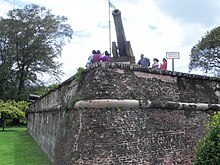
However, it is Captain Francis Light who is honoured as the founding father of Penang. Under instructions from the British East India Company, which had been seeking to break the Dutch monopoly of the spice trade in South-east Asia and establish trade relations in the Malay Peninsula, Captain Francis Light landed on Penang Island on 17 July 1786. Fort Cornwallis was later erected at the spot where Light had first set foot.
For Light, Penang Island was a "convenient magazine for trade", and its strategic location could be utilised by the Royal Navy as a repair base.[26] Furthermore, by gaining control of the island, the British would be able to check Dutch and French territorial gains in South-east Asia.
At that point, Penang Island was part of the Kedah Sultanate, which faced Siamese and Burmese threats.[27] Taking advantage of the situation, Light brokered with Sultan Abdullah Mukarram Shah of Kedah regarding the cession of Penang Island to the British East India Company in exchange for British military protection.[28]
Once an agreement was signed between Light and the Sultan, Light returned to Penang Island on 11 August. The Union Jack was then raised, signifying the formal possession of the island by the British East India Company "in the name of His Britannic Majesty, King George III". Penang Island was renamed the Prince of Wales Island after the heir to the British throne, while a new settlement, named George Town in honour of King George III, was created at the island's north-eastern tip.[29]

George Town was created out of a swamp. While Fort Cornwallis was being constructed, Light encouraged immigrants to the new settlement by firing silver coins into the jungles.[28] He also developed George Town as a free port to attract traders from Dutch ports in the region.[30] The number of incoming vessels to the Prince of Wales Island rose from 85 in 1786 to 3,569 in 1802; George Town's population had also increased to 10,000 by 1792.[31][32][33]
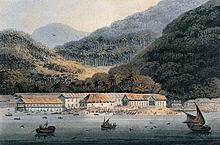
Colonial Era

The British East India Company intended to turn the Prince of Wales Island into a centre of spice production in South-east Asia. The cultivation of pepper began soon after the founding of the island by Captain Francis Light in 1786.[34] Spice production gradually grew more varied and agricultural plantations were established in the hilly interior of the island. The export of spices then allowed the Company to cover the administrative costs of Penang.[35][36] The agricultural plantations would also fuel the growth of the villages of Air Itam and Balik Pulau, where the clove and nutmeg farms attracted Malay refugees fleeing the Siamese invasion of Kedah and Chinese immigrants.[37][38]
The first Indian convict labourers were also sent to the Prince of Wales Island in the 1790s, thus beginning the practice of employing Indian convicts for the island's development.[34] Main roads were extended from George Town proper into the agricultural farms further inland, swamps were drained and the jungles cleared. Pipeworks were then laid to facilitate the supply of clean water. Some were also involved in the construction of administrative and military buildings in George Town, such as Fort Cornwallis.[39] Indeed, convict labour was key to Penang's successful colonisation as many found employment in the civil service, military, and as private servants to the colonial officials.
In 1826, the Prince of Wales Island, along with Province Wellesley (now Seberang Perai, the mainland part of Penang), Malacca and Singapore, were amalgamated into the Straits Settlements. Originally, George Town was made the capital. However, the capital was later shifted to Singapore in 1832, as the Port of Singapore was more strategically located along the India-China naval route and had already surpassed George Town as the preeminent harbour in the region.[40]

Nonetheless, the Prince of Wales Island continued to retain a secondary importance to Singapore.[41][42] Apart from being a centre of spice production and funnelling the exports meant for global shipping lines which had bypassed other regional ports, the tin mining boom in neighbouring Perak towards the end of the 19th. century transformed the Port of Penang into a major tin-exporting harbour in the Malay Peninsula, directly challenging the Port of Singapore.[43][44]

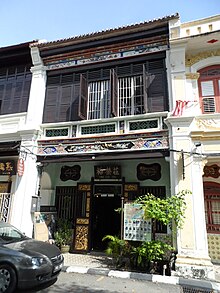
The growth of the Prince of Wales Island as an entrepôt led to the burgeoning of the island's population and the rapid development of George Town. Immigrants and traders flooded in from all over, including the Arabs, Jews, Germans and Armenians, bringing along their diverse cultures and religions. In particular, the Peranakans, who had settled in the region for generations, were also moving into George Town from Malacca; known as the King's Chinese, they would rise to prominence in Penang's economic and political scene, as well as leaving a lasting mark in Penang's architecture and cuisine.[45][46] In addition, the town of Bayan Lepas, at the south-eastern part of Penang Island, came into being towards the end of the 19th century.[47]
For ten days in August 1867, the Penang Riot erupted in George Town due to the fierce enmity between rival secret societies Kean Teik Tong (Tua Pek Kong Hoey) and Ghee Hin Kongsi. The British authorities under newly appointed Lieutenant-Governor Col. Edward Anson put down the rioting with sepoy reinforcement after days of chaos.
Also in the same year, the Straits Settlements was made a British crown colony, which in effect meant the transfer of the administration of Penang, Singapore and Malacca from the hands of the British East India Company into the Colonial Office in London. Direct British rule meant better enforcement of the rule of law, as Penang's police force was rapidly improved and the secret societies that had plagued George Town during the preceding decades were gradually outlawed.[41][48] Other than that, the Prince of Wales Island was renamed Penang Island by the end of that year.[49]
At the turn of the century, George Town, with a majority Chinese population, was a natural place for the Chinese nationalist Sun Yat-sen to raise funds for his revolutionary efforts in Qing China. His frequent visits culminated in the famous 1910 Penang conference which paved the way to the ultimately successful Wuchang uprising that overthrew the Manchu government.
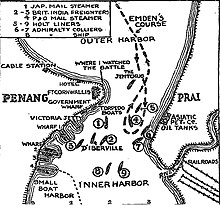
World Wars
At the start of World War I in 1914, SMS Emden, an Imperial German Navy cruiser, sank two Allied warships off the northern coast of Penang Island, in what would become known as the Battle of Penang. 147 French and Russian sailors were killed, while the others were rescued by local Malay fishermen.[50]
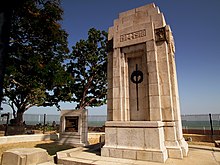
World War II, on the other hand, brought unprecedented social and political upheaval to Penang. Between 9 December and 18 December 1941, Japanese warplanes indiscriminately strafed and bombed George Town, as well as destroying the outdated Royal Air Force and Royal Australian Air Force squadrons defending Penang.[53][54] It was estimated that 600 civilians died as a result of the Japanese bombardment, with an additional 1,100 wounded.
Eighty Japanese fighters and bombers had flown over Georgetown unopposed... Thousands of people had filled the streets to watch the spectacle, which turned to tragedy when the bombs began to fall. Aircraft had then wheeled down to dive-bomb and strafe. Mass panic was the result of the bombing, and Penang had no anti-aircraft guns and few air raid shelters. Most of the bombs fell by design on Georgetown's densely populated Chinatown...[55]
— Allen Warren, British historian.
While the British Army had earlier designated Penang Island as a fortress, Lieutenant-General Arthur Percival then decided on a withdrawal from Penang. Not only did the British Army abandon the Batu Maung Fort at the south-eastern tip of Penang Island without a fight, they also silently evacuate Penang's European population, leaving the rest of Penang's civilians to their fates.[56] Historians have since argued that the withdrawal and the covert evacuation of the white race led to the loss of the sense of British invincibility, and that the "the moral collapse of British rule in Southeast Asia came not at Singapore, but at Penang".[57]


Penang Island fell to the Imperial Japanese Army on 19 December 1941, marking the start of a brutal period of Japanese occupation.[58][59] The island was renamed Tojo-to in honour of the then Japanese Prime Minister Hideki Tojo.[60] This period was especially renowned for the Imperial Japanese Army's massacres of Penang's Chinese populace, also known as Sook Ching to the locals.[61] Women in Penang were also coerced to work as comfort women by the Imperial Japanese Army.
During the Japanese occupation, George Town's harbour facilities were used as a major U-boat base by Nazi Germany.[62][63] Between 1942 and 1944, the Port of Penang was utilised by Axis submarines of the Imperial Japanese Navy, the Kriegsmarine and the Regia Marina.[64][65][66]
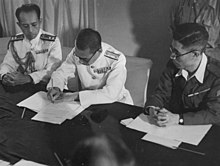
Between 1944 and 1945, Royal Air Force and United States Army Air Force bombers based in British India repeatedly bombed George Town, seeking to destroy the naval facilities and administrative buildings.[67] The Penang Secretariat building was destroyed by the Allied bombardment, causing the loss of the greater part of the British and Japanese records concerning Penang.[68] The Penang Strait was also mined to cripple Japanese shipping.[69]
Following the Japanese surrender on 15 August 1945, the Penang Shimbun published the proclamation of surrender by the Emperor of Japan on 21 August. Under Operation Zipper, the British Royal Marines accepted the surrender of the Japanese garrison in Penang and recaptured Penang Island on 3 September 1945.
Post-War
The British dissolved the Straits Settlements in 1946, and proceeded to merge the crown colonies of Penang and Malacca into the Malayan Union; Singapore was to be governed as a separate crown colony. The Malayan Union was eventually replaced with the Federation of Malaya in 1948.
However, the impending absorption of the British colony of Penang into the vast Malay heartland alarmed Penang's population over economic and ethnic concerns.[70] The Penang Secessionist Movement (active from 1948 to 1951) was formed to prevent Penang's merger with Malaya, and was spearheaded by, among others, the Penang Chinese Chamber of Commerce, the Penang Indian Chamber of Commerce, and the Penang Clerical and Administrative Staff Union.[71] A secession motion tabled in the Penang Settlement Council in 1949 was narrowly defeated by British official votes, while another petition sent to London also met with British disapproval in 1951.[72][73][74] The British government responded to the concerns raised by the secessionists by guaranteeing George Town's free port status, as well as reintroducing municipal elections in George Town in 1951.[72]

On 1 January 1957, George Town was declared a city by Queen Elizabeth II, becoming the first city in the Federation of Malaya. George Town continued to be the only city within Malaysia (other than Singapore between 1963 and 1965) until 1972, when Kuala Lumpur was granted city status.
Post-Independence
The revocation of George Town's free port status by the Malaysian federal government in 1969 caused unemployment in the city to soar to 16% and per capita income to plunge considerably.[73][75][76][77] This also contributed to George Town's gradual decline, which lasted until the early 2000s.[78] As the Malaysian federal government continued to develop Kuala Lumpur and nearby Port Klang by controlling investments in communication, transport, education and health, Penang began to suffer considerable brain drain as younger Penangites started emigrating out of the state for better employment opportunities.[75][79][80][81][82][83]
To reverse Penang's economic downturn, the then Chief Minister of Penang, Lim Chong Eu, created the Bayan Lepas Free Industrial Zone adjacentnext to the Penang International Airport, thus transforming the former agricultural town by industrialisation. Pioneer tax status was offered to attract multi-national electronic firms to set up factories and assembly plants in Bayan Lepas.[84] Complemented by low-cost labour, the Bayan Lepas Free Industrial Zone managed to pull Penang out from its economic slump and grew to become the Silicon Valley of the East.[85]

In an attempt to reverse George Town's decline, the Komtar project was launched in 1974. Hundreds of shophouses, schools and temples, as well as whole streets, were erased from the map in order to make way for the construction of Penang's tallest skyscraper.[75] However, instead of arresting George Town's decline, Komtar itself became a white elephant by the 2000s.[86][87][88][89]
The Penang Bridge linking Penang Island with the rest of Peninsular Malaysia was opened in 1985 by the then Malaysian Prime Minister, Mahathir bin Mohamad. It was the longest bridge in South-east Asia until 2014, when it was superseded by its southern sibling, the Second Penang Bridge.
Renaissance
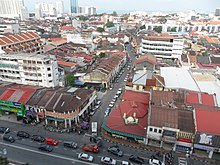
The pre-war houses in the centre of George Town was, for half a century until January 2001, protected from urban development by the Rent Control Act which prohibited landlords from arbitrarily raising rentals as a measure to provide affordable housing to the low-income population.[90] Its eventual repeal visibly changed the landscape of Penang's demographic pattern and economic activity - it led to overnight appreciation of house and real estate prices, forcing out tenants of multiple generations out of their homes to the city outskirts and the development of new townships and hitherto sparsely populated areas of Penang; the demolition of many heritage houses, and the mushrooming of high-rises and office blocks; and the dilapidation of the city centre. Uncontrolled development sparked concerns of the continued existence of heritage buildings and Penang's collection of pre-war houses, leading to more vigorous conservation efforts.
In 2008, George Town was inscribed as a UNESCO World Heritage Site. It was a recognition of the conservation efforts to protect the "unique architectural and cultural townscape without parallel anywhere in East and Southeast Asia".[6][91] The subsequent sprucing up of George Town and strict measures to improve traffic flow, pedestrianisation and environmental aspects by the newly elected Pakatan Rakyat state government also led to George Town being ranked the 8th most liveable city in Asia by ECA International in 2010.[7][8][9][92][93][94][95]
The Indian Ocean tsunami which struck on 26 December 2004 hit the western and northern coasts of Penang Island, including George Town, claiming 52 lives (out of 68 in Malaysia).
Whilst George Town had been declared a city by Queen Elizabeth II in 1957, the entire Penang Island was also granted city status by the Malaysian federal government in 2015.[96]
Geography

With an area of 293 km2 (113 sq mi), slightly ⅓ the size of Singapore, Penang Island is the fourth-largest island in Malaysia.[97] It is also the most populated island in the country with an estimated population of 738,500.[5] Therefore, Penang Island has the highest population density of all Malaysian cities.[98]

Penang Island is geographically separated from the Malay Peninsula by the Penang Strait. As for the terrain, much of the centre of Penang Island consists of granitic hills covered by rainforest jungles. The central hills of Penang Island, including Penang Hill, serve as a giant green lung for the entire island and an important forested catchment area.[99]
Generally-speaking, the island can be distinguished into five areas:
- The northeastern plains form a triangular promontory where George Town is centred. This densely populated city centre is the administrative, commercial and cultural centre of Penang.
- The southeast, where Bayan Lepas is located, was once an agricultural area consisting of rice fields and mangroves. Due to the massive industrialisation of the 1970s, this area has been developed into new townships and industrial areas.
- The north, including Batu Ferringhi, Tanjung Bungah and Tanjung Tokong, consists of narrow sandy beaches lined with resort hotels and residences that form the north-western edge of George Town.
- The southwest (Balik Pulau) contains the only large pockets of scenic countryside with fishing villages, fruit orchards, and mangroves.
- The central hill range, with the highest peak being Penang Hill at 735 metres above sea level, is an important forested catchment area.
In recent decades, the urbanisation of George Town has led to the development of residential suburbs, such as Pulau Tikus, Air Itam, Paya Terubong, Jelutong and Gelugor. The southward expansion of George Town along the eastern seaboard of Penang Island has merged its southern-most suburb, Gelugor, with Bayan Lepas, thereby urbanising the entire eastern coast of Penang Island.
As with most island cities, land scarcity is a pressing issue on Penang Island. Land reclamation projects have been carried out to provide more low-lying land in high-demand areas, such as at Karpal Singh Drive, Gurney Drive, Tanjung Tokong and Queensbay.
Cityscape

Street Names
Unlike other cities in Malaysia, George Town still keeps most of its English street names. Even for roads that have been officially renamed in Malay, such as Jalan Masjid Negeri, Penangites in general still prefer to use the road's former English name, which in this particular case is Green Lane. This is partly because the new names are often unwieldy (e.g. Pitt Street vs Jalan Masjid Kapitan Keling, Northam Road vs Jalan Sultan Ahmad Shah), but also indicates strong conservatism among Penangites, who see Penang's colonial history as part of their local identity.
In addition, since 2008, multi-lingual road signs have been in use throughout Penang Island. Each of the new road signs has the road's official Malay name and either the street's English, Chinese, Tamil or Arabic name.[100][101][102] To this day, Penang Island is the only city in Peninsular Malaysia to have multi-lingual road signs.
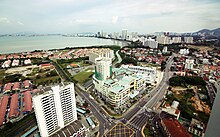


Urban and Suburban Areas
The expansion of George Town has created suburbs to its north-west, west and south. The north-western suburbs are somewhat more affluent, given their seafront locations which attract tourists and expatriates. The southern suburbs, such as Jelutong, grew due to industrial activities.[103] On the other hand, Air Itam and Paya Terubong emerged to the west of George Town as a result of agricultural plantations on the central hills of Penang Island.
The suburbs of George Town are as follows.
| Batu Ferringhi | Pulau Tikus | Batu Lanchang |
|---|
At the south-eastern part of Penang Island, the former agricultural town of Bayan Lepas has grown into an industrial town, while townships and neighbourhoods have spread, merging with George Town's southern suburbs and urbanising the whole eastern seaboard of Penang Island. The townships and villages around Bayan Lepas are as listed below.
| Batu Maung | Sungai Dua |
|---|
The south-western part of Penang Island, where the agricultural town of Balik Pulau is located, also consists of a number of fishing villages and fruit orchards. These fishing villages include Gertak Sanggul and Pantai Acheh.
Tucked away near the north-western tip of Penang Island is the fishing village of Teluk Bahang, which has been experiencing increased tourist arrivals due to the opening of a handful of attractions there.

Beaches

The north-western edge of George Town - at Batu Ferringhi and Tanjung Bungah - is lined with some of the most popular beaches in Penang, as well as a hotel and resort belt that includes Hard Rock Hotel. However, decades of sea pollution have degraded the beauty of the beaches somewhat and led to the infestation of jellyfishes along the northern coast of Penang Island.[104]
More pristine beaches can be found within the Penang National Park, which covers the north-western tip of Penang Island. These include Monkey Beach and Kerachut Beach.

Hills
The central hills of Penang Island serve as a gigantic green lung and water catchment area for the urbanised island.
Penang Hill, with tallest peak on Penang Island, lies near the centre of the island and west of Air Itam. The peak, 735 meters above sea level, is accessible via the Penang Hill Railway from its base station at Air Itam. Once visited by British officials and Queen Elizabeth II, the peak of Penang Hill is one of Penang's most well-known tourist attractions, with 1.36 million tourist arrivals in 2014.[105][106]

Parks and Gardens
The main park within George Town is the Penang Botanic Gardens, located to the west of Pulau Tikus. Founded in 1884 as an offshoot of the Singapore Botanic Gardens, the Penang Botanic Gardens is the oldest botanical garden in Malaysia. It now serves as the city's green lung and a major recreational area, receiving about 5,000 visitors every weekend.[107] The botanical gardens also encompasses a youth recreational park and Penang's biggest waterfall, which contributes between 10% to 15% of Penang Island's water supply.[108]
Gazetted in 2003, the Penang National Park, west of Teluk Bahang, is the country's smallest national park. Within the 2,562 hectares of protected rainforest, lie mangrove swamps, mud flats, coral reefs and pristine beaches where turtles can be occasionally spotted laying eggs.[109]
| Penang | ||||||||||||||||||||||||||||||||||||||||||||||||||||||||||||
|---|---|---|---|---|---|---|---|---|---|---|---|---|---|---|---|---|---|---|---|---|---|---|---|---|---|---|---|---|---|---|---|---|---|---|---|---|---|---|---|---|---|---|---|---|---|---|---|---|---|---|---|---|---|---|---|---|---|---|---|---|
| Climate chart (explanation) | ||||||||||||||||||||||||||||||||||||||||||||||||||||||||||||
| ||||||||||||||||||||||||||||||||||||||||||||||||||||||||||||
| ||||||||||||||||||||||||||||||||||||||||||||||||||||||||||||
Teluk Bahang is also home to unique agricultural attractions, such as the Penang Butterfly Farm, Tropical Spice Garden and Tropical Fruit Farm.[110][111][112]
Drainage System
The major rivers on Penang Island include the Pinang River, Air Itam River, Gelugor River, Dondang River, Teluk Bahang River, Tukun River and Betung River. Two dams store Penang Island's water supply - Teluk Bahang Dam and Air Itam Dam. The Penang Botanic Gardens Waterfall also contributes between 10% to 15% of Penang Island's water supply.
Climate
Like the rest of Malaysia, Penang Island has a tropical rainforest climate under the Köppen climate classification (Af), although it also borders on a tropical monsoon climate. Penang Island does experience slightly drier conditions between December and February of the following year. The city sees on average around 2,477 millimetres (97.5 in) of precipitation annually with the lowest being 60 millimetres (2.4 in) in February while the highest was around 210 millimetres (8.3 in) between August and October.[113]
Penang Island's proximity to the island of Sumatra, Indonesia makes it susceptible to dust particles carried by wind from the perennial but transient forest fires, creating a yearly phenomenon known as the Southeast Asian haze.[114][115] The haze season typically hits between July and October.
Weather forecasts in Penang Island is served by the Bayan Lepas Regional Meteorological Office, which acts as the primary weather forecast facility for northern Peninsular Malaysia.[116]
| Climate data for Penang | |||||||||||||
|---|---|---|---|---|---|---|---|---|---|---|---|---|---|
| Month | Jan | Feb | Mar | Apr | May | Jun | Jul | Aug | Sep | Oct | Nov | Dec | Year |
| Mean daily maximum °C (°F) | 31.6 (88.9) |
32.2 (90.0) |
32.2 (90.0) |
31.9 (89.4) |
31.6 (88.9) |
31.4 (88.5) |
31.0 (87.8) |
30.9 (87.6) |
30.4 (86.7) |
30.4 (86.7) |
30.7 (87.3) |
31.1 (88.0) |
31.3 (88.2) |
| Daily mean °C (°F) | 26.9 (80.4) |
27.4 (81.3) |
27.6 (81.7) |
27.7 (81.9) |
27.6 (81.7) |
27.3 (81.1) |
26.9 (80.4) |
26.8 (80.2) |
26.5 (79.7) |
26.4 (79.5) |
26.5 (79.7) |
26.7 (80.1) |
27.0 (80.6) |
| Mean daily minimum °C (°F) | 23.2 (73.8) |
23.5 (74.3) |
23.7 (74.7) |
24.1 (75.4) |
24.2 (75.6) |
23.8 (74.8) |
23.4 (74.1) |
23.4 (74.1) |
23.2 (73.8) |
23.3 (73.9) |
23.3 (73.9) |
23.4 (74.1) |
23.5 (74.4) |
| Average rainfall mm (inches) | 68.7 (2.70) |
71.7 (2.82) |
146.4 (5.76) |
220.5 (8.68) |
203.4 (8.01) |
178.0 (7.01) |
192.1 (7.56) |
242.4 (9.54) |
356.1 (14.02) |
383.0 (15.08) |
231.8 (9.13) |
113.5 (4.47) |
2,407.6 (94.79) |
| Average rainy days (≥ 1.0 mm) | 5 | 6 | 9 | 14 | 14 | 11 | 12 | 14 | 18 | 19 | 15 | 9 | 146 |
| Mean monthly sunshine hours | 248.8 | 233.2 | 235.3 | 224.5 | 203.6 | 202.4 | 205.5 | 188.8 | 161.0 | 170.2 | 182.1 | 209.0 | 2,464.4 |
| Source: NOAA[117] | |||||||||||||
Government and Politics
Local Government
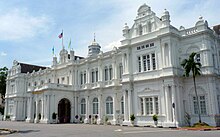
Local administration of Penang Island, including George Town, is under the purview of the Penang Island City Council, an agency of the Penang state government. With a history dating back to 1800, it is the oldest local council in Malaysia and the successor to the country's first city council - the George Town City Council.
Headquartered in the City Hall, George Town, the city council is responsible for urban planning, heritage preservation, public health, sanitation, waste management, traffic management, environmental protection, building control, social and economic development, and general maintenance of urban infrastructure.
The Mayor is appointed by the Penang state government for two years, while each of the 24 councillors is appointed for a one-year term.[118] The current Mayor of Penang Island is Patahiyah Ismail, who took office in 2015.[119]
State and Federal Legislature

For the unicameral Penang State Legislative Assembly, Penang Island is divided into by 19 state constituencies. The Assemblymen and -women are elected into office via Penang-level elections, which by convention is held simultaneously with the Malaysian General Election every five years.
Penang Island is also represented by six Members of Parliament in the Parliament of Malaysia. The Members of Parliament are elected via the Malaysian General Election, which is held every five years.
The current State Assemblymen (and -women) and Members of Parliament for Penang Island are as listed below.
| Federal Constituency | Party | Member of Parliament | State Constituency | Party | State Assemblyman |
|---|---|---|---|---|---|
| Bukit Bendera | DAP | Zairil Khir Johari | Tanjong Bunga | DAP | Teh Yee Cheu |
| Air Puteh | DAP | Lim Guan Eng | |||
| Kebun Bunga | PKR | Cheah Kah Peng | |||
| Pulau Tikus | DAP | Yap Soo Huey | |||
| Tanjong | DAP | Ng Wei Aik | Padang Kota | DAP | Chow Kon Yeow |
| Pengkalan Kota | DAP | Lau Keng Ee | |||
| Komtar | DAP | Teh Lai Heng | |||
| Jelutong | DAP | Jeff Ooi Chuan Aun | Dato Keramat | DAP | Jagdeep Singh Deo |
| Sungai Pinang | DAP | Lim Siew Khim | |||
| Batu Lanchang | DAP | Law Heng Kiang | |||
| Bukit Gelugor | DAP | Ramkarpal Singh | Seri Delima | DAP | RSN Rayer |
| Air Itam | DAP | Wong Hon Wai | |||
| Paya Terubong | DAP | Yeoh Soon Hin | |||
| Bayan Baru | PKR | Sim Tze Tzin | Batu Uban | PKR | Jayabalan s/o Thambyappa |
| Pantai Jerejak | PKR | Mohd Rashid Hasnon | |||
| Batu Maung | PKR | Abdul Malik bin Abdul Kassim | |||
| Balik Pulau | BN | Hilmi Yahaya | Bayan Lepas | BN | Nordin bin Ahmad |
| Pulau Betong | BN | Muhammad Farid Saad | |||
| Telok Bahang | BN | Shah Haedan bin Ayoob Hussain Shah |
As the capital of Penang, George Town houses both the Penang State Legislative Assembly and the office of the Chief Minister of Penang, which is located at the 28th. floor of Komtar Tower, the tallest skyscraper in Penang.[120] George Town also hosts federal government agencies and departments. Moreover, several nations have set up or appointed consulates in George Town, befitting its status as an important Malaysian city.
Judiciary

The Malaysian legal system had its roots in George Town. In 1807, a Royal Charter was granted to Penang which provided for the establishment of a Supreme Court. This was followed by the appointment of the first Supreme Court judge designated as the Recorder.
The Supreme Court of Penang was first opened at Fort Cornwallis on 31 May 1808. The first Superior Court Judge in Malaya originated from Penang when Sir Edmond Stanley assumed office as the First Recorder (later, Judge) of the Supreme Court of Penang in 1808. The Supreme Court was then relocated a short distance away to Light Street, where the present building was built in the 1903.
The legal establishment in George Town was gradually extended to the whole of British Malaya (including Singapore).[105] After the nation's independence, the Malaysian judiciary has become largely centralised. The courts in Penang consist of the Magistrates, Sessions, and the Supreme Court, which remains at Light Street to this day.
The Syariah court is a parallel court which hears matters under Islamic jurisprudence.
Demographics

According to the 2010 census by the Malaysian federal government, Penang Island had a population of 708,127. More recent estimates from the Penang Institute, a Penang-based think tank, indicated that the island had about 738,500 residents by 2012.[121] These figures placed Penang Island as Malaysia's second largest city by population.
In addition, Penang Island's population is part of the approximately 2.5 million inhabitants within the Greater Penang conurbation, which also covers Seberang Perai (the mainland portion of Penang) and the southernmost part of neighbouring Kedah. Thus, Greater Penang is the most populous metropolitan area in Malaysia outside of Klang Valley (Greater Kuala Lumpur).
Ethnicities
Statistics from Universiti Sains Malaysia showed that in 2010, the racial composition on Penang Island was about 45.8% Chinese and 36.8% Malay.[122] These were in addition to small Indian and Eurasian minorities. In particular, most of the nearly 1,500 Eurasians remain concentrated at Pulau Tikus.[123][124][125]
During the colonial era, there were also Siamese, Burmese, Filipino, Ceylonese, Japanese, Sumatran, Arab, Armenian, and Parsee communities in George Town, as well as a tiny but commercially significant community of German merchants.[126][127] Although most of these communities are now extinct, they lent their legacy to several street and place names in George Town, such as Siam Road, Armenian Street and Gottlieb Road.
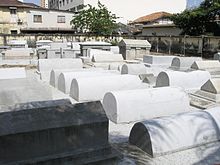
The Peranakans, descendants of mixed Malay and Chinese ancestries, had simultaneously lived throughout the Straits Settlements for generations. The Peranakan community on Penang Island, which included tycoons like Chung Thye Phin, Lim Boon Keng and Khoo Sian Ewe, would go on to wield considerable influence in protecting Penang's commercial and political interests; the Penang Chinese Chamber of Commerce and the Penang Straits Chinese British Association were led by Peranakans, and Penang was represented by the Peranakans in the Straits Settlements Legislative Council.[128] As the Peranakans tended to be more loyal to the British Crown than to China, they were also known as the King's Chinese. To this day, Peranakan influence is still visible in the form of Straits Chinese architectural styles and dishes like asam laksa.
A Jewish enclave in George Town had existed prior to World War II, but the Jewish community in George Town is believed to be all but extinct.[126][129][130]
George Town currently has a significant expatriate population, particularly from Singapore, Japan and various Asian countries as well as the United Kingdom, many of whom chose to retire in Penang as part of the Malaysia My Second Home programme. In recent years, George Town has been acknowledged as one of the best cities to retire within South-East Asia, as reported by CNN and Forbes.[131][132]
Languages
As with other multi-ethnic cities in Malaysia, all four major languages are widely spoken on Penang Island - Malay, English, Chinese and Tamil. However, the island is best known for its distinct Hokkien dialect, known as Penang Hokkien.
Under British rule, English was the official language. This was helped by the growth of missionary schools throughout George Town, including Penang Free School, St. Xavier's Institution, St. George's Girls' School, Catholic Convent schools and Methodist schools, all of which used English as their medium of instruction and were held in high esteem by the locals.[133] Most Penangites have at least reasonable command of the language; while British English is formally used, spoken English usually takes the form of Manglish.[134] Notably, Penang Island is the only city in Malaysia that retains most of its English street names, as can be seen on the multi-lingual street signs in the city.
As with the rest of Malaysia, Malay is currently the official language on Penang Island. The Malays of Penang Island also use a unique dialect similar to Kedah Malay, with characteristic words such as hang, depa, pi and kupang. Syllables ending with aq are usually stressed.
Due to their Tamil ancestry, most Indians speak Tamil. Punjabi, Malayalam and Telugu are also spoken by smaller numbers of Indians on Penang Island.
Meanwhile, the Chinese population uses a variety of Chinese dialects, reflective of their forebears' different places of origins in southern China. These include Hakka and Cantonese, while Mandarin, more widely used by youths, has been the medium of instruction in Chinese schools throughout Penang.
However, it is Penang Hokkien that serves as the lingua franca, particularly in George Town. Originally a variant of the Minnan dialect, over the centuries, Penang Hokkien has absorbed a large number of loanwords from Malay and English, yet another legacy of the Peranakan culture.[135] It is spoken by many Penangites regardless of race for daily communication, so much so that even police officers also take courses in Penang Hokkien.[136][137][138] In recent years, steps are being taken to maintain the dialect's importance in the face of increasing influence of Mandarin and English, including through books, dictionaries and movies.[139][140]
Economy

Penang Island is one of the major economic powerhouses of Malaysia. The 'Silicon Valley of the East' is one of the top contributors of Malaysia's Gross Domestic Product (GDP) and tax income.[141][142] While George Town was originally established as an entrepôt by the British, the economic sectors on Penang Island now vary, from commerce to manufacturing.
Penang Island also acts as the economic pole of northern Malaysia, with relatively well-developed logistical connectivity. The Penang International Airport is one of the country's busiest in terms of cargo tonnage and passenger traffic, while the Port of Penang remains the most important entrepôt in northern Malaysia, handling the second largest total container throughput (TEU) in Malaysia.[143]
The top sectors in Penang's economy are services and manufacturing. The major component of Penang's manufacturing sector, in particular, is the Bayan Lepas Free Industrial Zone, where numerous multi-national electronics and engineering firms have set up factories since the 1970s. Meanwhile, the services sector is slated to become the largest economic sector in Penang, due to the island's reputation as a famous tourist destination and the outsourcing of advanced services to the state. The high concentration of international banks in George Town has also made Penang Island the financial centre of northern Malaysia.
Overall, Penang has the third largest economy of all Malaysian states, contributing as much as RM6.302 billion of Malaysia's tax income in 2014.[144][145] As of 2015, Penang's GDP per capita has risen to RM44,847, the highest among Malaysian states (excluding Kuala Lumpur).[146][147][148] Furthermore, Penang constantly records one of the lowest unemployment rates in the country - 1.5% in 2015.[149][150] Penang's Gini coefficient is also one of the nation's lowest, standing at 0.364 in 2014, which was lower than the national mean of 0.401.[151] In terms of foreign direct investment, Penang attracted nearly RM4.5 billion in 2015, the largest amount in Malaysia; this underlines Penang's potential as a favourite for foreign investors.[152][153]
Manufacturing
Massive industrialisation since the 1970s has led to manufacturing becoming one of Penang's top economic sectors, contributing as much as 47.4% of Penang's total GDP in 2015.[154] Penang's manufacturing sector is one of the largest in the state's economy, contributing as much as 48.3% of Penang's GDP in 2013.[155] Of Penang's total exports during the first nine months in 2014, machinery and transport equipment accounted for 71%.
As the 'Silicon Valley of the East', the Bayan Lepas Free Industrial Zone is now home to the factories of several multi-national firms specialising in electronics and engineering.[156] Among them are Bosch, Dell, Intel, Osram, Plexus Corporation, Motorola, Hitachi and Hewlett Packard.
Commerce


George Town was once the centre of banking in Malaysia, at a time when Kuala Lumpur was still a small outpost. The first international bank to open a branch in Malaysia was Standard Chartered Bank (then the Chartered Bank of India, Australia and China) in 1875, with a main branch in George Town.[157] The Hongkong and Shanghai Banking Corporation (HSBC) and the Royal Bank of Scotland (then ABN AMRO) followed suit by opening their George Town branches in 1885 and 1888 respectively.[156]
To this day, George Town remains the banking centre of northern Malaysia, with branches of Citibank, United Overseas Bank, Oversea-Chinese Banking Corporation, Bank of China and Bank Negara Malaysia (Malaysian central bank) together with local banks such as Public Bank, Maybank, Ambank and CIMB Bank. Most of the older international banks still retain their Penang headquarters at Beach Street, George Town's financial centre.
Tourism
Penang Island has always been one of the most popular tourist destinations in Malaysia. Over the centuries, the island has even welcomed some of the most influential personalities, including Somerset Maugham, Rudyard Kipling, Noël Coward, Lee Kuan Yew and Queen Elizabeth II. In 2014, Penang attracted about 6.84 million tourists.[158]
Penang Island's various attractions include the impressive array of heritage architecture, its multicultural society, a wide range of modern entertainment and retail choices, natural features such as beaches and verdant hills, and the world-famous Penang cuisine. The city's low cost of living and well-developed infrastructure have also been cited as pull factors.[159]
In recent years, George Town has received numerous international accolades, further putting the city on the world stage. In 2016, George Town was recommended as one of the 16 must-see destinations by the Los Angeles Times, as well as one of the top ten by the Lonely Planet.[160][161] Forbes has also listed George Town as one of the best budget tourist destinations in 2016.[162] These are in addition to Penang Island's reputation as a gastronomic haven, with the CNN placing the city as one of Asia's best street food cities.[163]
Services
In recent years, the services sector, driven mainly by tourist arrivals into Penang Island, has become one of the top economic sectors in Penang. With nearly two thirds of Penang's workforce employed in services-related industries, this particular sector has also overtaken manufacturing as Penang's biggest economic sector, contributing 48.6% of Penang's total GDP in 2015.[154]
Within Penang's services sector, the greatest proportion of employment was recorded in the retail, accommodation, and food and beverages (F&B) sub-sectors, clearly indicating the influence of tourist arrivals on service-related industries.
Penang's services sector is also boosted by shared services outsourcing (SSO) firms, including AirAsia, Citigroup and Temasek Holdings; the SSO sub-sector has earned a yearly revenue of RM12.79 billion by 2013 and created over 8,000 jobs.[164][165]
Medical Tourism

An integral part of Penang's services sector is medical tourism, which has made George Town the medical tourism hub of Malaysia. The city attracted approximately half of the nation's medical tourist arrivals in 2013 and generated about 70% of Malaysia's medical tourism revenue.[166][167][159] About 1,000 patients arrive on Penang Island daily, mostly from Asian countries such as Indonesia, Singapore and Japan.
The success of Penang's medical tourism industry is mainly due to the specialised medical treatments offered at more affordable costs by the numerous private hospitals on Penang Island, coupled with well-trained professionals and advanced equipment.[159] Indirect factors that were cited include the low cost of living, the laid-back lifestyle and the ease of travel facilitated by the relatively well-developed logistical infrastructure.[166]
Retail

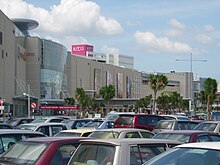
Due to the several shopping malls and hypermarkets on Penang Island, the city is the main shopping hub of northern Malaysia. The retail sub-sector is supported by the large number of tourist arrivals, and Penang's well-developed logistical connections and infrastructure, which facilitated the import of goods. Since 2001, shopping complexes in George Town registered the biggest increases in Malaysia.[168]

In particular, the shopping malls in George Town are the major draws for shoppers. Within the vicinity of Komtar are 1st. Avenue Mall, Prangin Mall and Penang Times Square. Upmarket shopping malls, Gurney Plaza and Gurney Paragon, are located next to each other along Gurney Drive. Suburban shopping malls have also sprung up in recent decades, including Straits Quay and Island Plaza at Tanjung Tokong, Udini Square at Gelugor and All Season's Place at Air Itam.[169][170][171]
The largest shopping mall on Penang Island is Queensbay Mall, located in Bayan Lepas. The 73 acre, 2.5 million ft2 complex was opened in 2006.
While shopping malls now dominate the retail scene, many centuries-old shophouses are still operating alongside the city's flea markets and wet markets. In George Town , these smaller retail establishments cater more to locally-made products, including spices, nutmegs and tau sar pneah, a famous Penang delicacy.[172]
This combination of both old and new creates a unique bustling retail sector on Penang Island.[173] In addition, as many as 24% of Penang's workforce are employed in the retail sub-sector, the largest of all economic sub-sectors in Penang.[154]
Entrepôt Trade
George Town was originally founded by the British as an entrepôt, and right up to the 1950s, George Town maintained the role of one of the major entrepôts in British Malaya.
This entrepôt trade has now greatly declined, due in part to the loss of George Town's free-port status and to the active development of Port Klang near Kuala Lumpur.[174][175][176] However, the Port of Penang still serves as the major harbour within the northern region of Malaysia. As of 2010, the Port of Penang handled over 1.1 million TEU of cargo, the second highest amount in Malaysia.[143]
Architecture
Centuries of development have brought a mix of architectural styles to Penang Island, both historical and modern. The centre of George Town has been inscribed as a UNESCO World Heritage Site due to its 'unique architectural and cultural townscape without parallel anywhere in East and Southeast Asia'.[91][177] Just outside the UNESCO zone lies the modern cityscape, with skyscrapers, residential high-rises, office blocks and shopping malls built all over the island city.


In particular, the older architecture reflects the legacy of 171 years of British rule, coalescing Malay, Chinese, Indian, Peranakan, Siamese, Burmese and other cultural influences. This blend of architectural styles is also ubiquitous in Malacca and Singapore, two fellow Straits Settlements which shared similar British colonial legacies. However, unlike Singapore, where many heritage buildings have been replaced by modern skyscrapers and high-rise apartments, George Town's architectural heritage has enjoyed a better fate. Since the 2000s, conservation efforts have brought previously derelict heritage buildings such as the famous Cheong Fatt Tze Mansion back to life.[178]

Historical Architecture
Most of George Town's famous heritage landmarks are located within its UNESCO World Heritage Site. One of the first structures to be constructed in George Town was Fort Cornwallis, which was built just weeks after Captain Francis Light had first landed in 1786.[44]
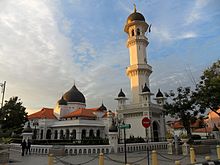
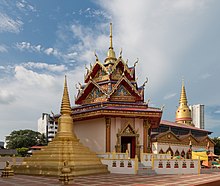
The governmental buildings in George Town were built in various colonial architectural styles. For example, the City Hall was built in the Edwardian Baroque style, whereas the Supreme Court features a Palladian architectural style, similar to that of St. George's Church.[179] The Eastern & Oriental Hotel is a sibling of Singapore's Raffles Hotel; both were founded by the Sarkies Brothers and built in colonial architecture.

Many of the bank headquarters along Beach Street, such as Standard Chartered Bank and HSBC were also constructed in the Art Deco styles.[180][181]
In addition, various Asian architectural styles can be seen throughout the UNESCO World Heritage Site, some of them combining different cultural influences. Kapitan Keling Mosque, the largest mosque within the zone, combines Moorish, Mughal and Islamic styles. Cheong Fatt Tze Mansion and the Pinang Peranakan Mansion both merge Chinese architecture and European interior design, while the Sun Yat-sen Museum is one of the countless examples of a typical Peranakan townhouse which dominates the cityscape.[182][183] Other unique examples of Chinese architecture include Khoo Kongsi and the Clan Jetties. Little India contains more Hindu and Indian Muslim architecture, such as the Sri Mahamariamman Temple and the Nagore Durgha Shrine.
Impressive heritage architecture outside the UNESCO World Heritage Site includes the colonial bungalows built by nouveau riche Chinese tycoons in the 19th century along Northam Road (now Jalan Sultan Ahmad Shah), and stately bungalows like The Residency and Suffolk House.
The Thai and Burmese communities have left their mark on George Town's landscape. At Pulau Tikus, Wat Chayamangkalaram is a Thai temple that is famous for its reclining Buddha statue, while Dhammikarama Burmese Temple is located nearby. Kek Lok Si, situated at Air Itam was completed in the 1930s, merging Chinese, Siamese and Burmese architectural styles into its main pagoda.

Modern Architecture
Since the mid 20th century, modern urbanisation has transformed much of Penang Island. Skyscrapers and high-rises have sprung up all over the city, sometimes side-by-side with heritage buildings. Industrial estates are concentrated within Bayan Lepas to the south.

Just south of the UNESCO World Heritage Site stands Komtar, the tallest skyscraper in Penang at nearly 250 meters tall. It forms the core of George Town's modern centre, surrounded by residential high-rises like Hotel Jen, St. Giles Wembley Hotel, Neo+ Hotel and Penang Times Square, as well as shopping centres including Prangin Mall, 1st. Avenue and Gama.
Skyscrapers and high-rises have also been constructed along George Town's northern shoreline from Northam Road (now Jalan Sultan Ahmad Shah) to Gurney Drive. Notably, the East and West Towers of Gurney Paragon, at 155 metres tall, are the second tallest skyscrapers in Penang.
With increasing urbanisation, high-rises are also springing up throughout Penang Island.
Notes
- ^ Mike Aquino (30 August 2012). "Exploring Georgetown, Penang". Asian Correspondent. Retrieved 1 January 2016.
- ^ Cavina Lim (25 March 2015). "Penang's first mayor a woman". The Star. Retrieved 24 January 2016.
- ^ "The Penang Island City agenda". The Sun Daily. 19 May 2014.
- ^ http://penangmonthly.com/an-analysis-of-penang/
- ^ a b "Population". Retrieved 20 October 2016.
- ^ a b "Eight new sites, from the Straits of Malacca, to Papua New Guinea and San Marino, added to UNESCO's World Heritage List". UNESCO (World Heritage Site). 7 July 2008. Archived from the original on 6 September 2015. Retrieved 8 July 2008.
{{cite web}}: Unknown parameter|deadurl=ignored (|url-status=suggested) (help) - ^ a b Chow, Tan Sin. "Penang's capital is eighth most liveable city in Asia, on par with KL and Bangkok - Nation | The Star Online". Retrieved 15 October 2016.
- ^ a b "Penang most liveable city in M'sia - Community | The Star Online". Retrieved 15 October 2016.
- ^ a b "quality of life". Penang Monthly. Retrieved 15 October 2016.
- ^ Christina Oon Khar Ee; Khoo Suet Leng (2004). "Issues and challenges of a liveable and creative city: The case of Penang, Malaysia" (PDF). Development Planning and Management Programme, School of Social Sciences, University of Science, Malaysia. p. 1/11. ISSN 2180-2491. Archived from the original (PDF) on 26 January 2016. Retrieved 26 January 2016.
{{cite web}}: Unknown parameter|deadurl=ignored (|url-status=suggested) (help) - ^ http://penangmonthly.com/medical-tourism-a-billion-ringgit-industry-for-penang/
- ^ http://www.thesundaily.my/news/1260128
- ^ http://www.worldportsource.com/ports/commerce/MYS_Port_of_Penang_1425.php
- ^ http://penangport.com.my/Profile/About-Penang-Port
- ^ Simon Gardner, Pindar Sidisunthorn and Lai Ee May 2011. Heritage Trees of Penang, p. 206. Penang: Areca Books. ISBN 978-967-57190-6-6
- ^ "Welcome to Penang State Museum". Penangmuseum.gov.my. Retrieved 9 November 2012.
- ^ a b Raymond, Boon. (19 March 2010) Penang, Penang lang(槟城人) lah : Penang is called Koh Maak, not Koh Opium. Teochiewkia2010.blogspot.com.[unreliable source?] Retrieved on 11 August 2011.
- ^ ปีนัง : พันเรื่องถิ่นแผ่นดินไทย โดยศ.ดร.เอนก เหล่าธรรมทัศน์ (Press release) (in Thai). Komchadluek. Retrieved 13 January 2013.
- ^ Penang Special Attractions | Penang Travel Tip | Best Tourist Location in Asia. Penangspecial.com. Retrieved on 11 August 2011.
- ^ "Betel Nut Island". Retrieved 13 September 2014.
- ^ "6 Spectacular Islands You Must Visit in Johor - JOHOR NOW". JOHOR NOW. 5 September 2016. Retrieved 20 October 2016.
- ^ "Sir James Lancaster (English merchant) – Britannica Online Encyclopedia". Encyclopedia Britannica. Retrieved 13 September 2014.
- ^ Khoo Su Nin, Streets of George Town, Penang; 2007
- ^ "Batu Uban, Penang / Pulau Pinang". Retrieved 20 October 2016.
- ^ Faridah Abdul Rashid, Research on the Early Malay Doctors 1900–1957 Malaya and Singapore, 2012
- ^ "JourneyMalaysia » The Arrival of the British and East India Company ~ Pulau Pinang / Penang , Malaysia (Article)". www.journeymalaysia.com. Retrieved 15 October 2016.
- ^ Swettenham; Frank Athelstane (1850–1946). "Map to illustrate the Siamese question". W. & A.K. Johnston Limited. University of Michigan Library. Retrieved 9 January 2016.
- ^ a b III, Administrator. "History of Penang". www.visitpenang.gov.my. Retrieved 15 October 2016.
- ^ Simon Richmond (2010). Malaysia, Singapore & Brunei. Lonely Planet. pp. 177–. ISBN 978-1-74104-887-2.
- ^ Ashley Jackson (November 2013). Buildings of Empire. OUP Oxford. pp. 7–. ISBN 978-0-19-958938-8.
- ^ "Malaysian Journal of Society and Space". Charting the early history of Penang trading networks and its connections with the new ASEAN growth triangle (Malaysia-Indonesia-Thailand).
- ^ Nordin, Hussin (1 December 2005). "Networks of Malay Merchants and the Rise of Penang as a Regional Trading Centre". The southeast asian studies. 43 (3): 215–237. ISSN 0563-8682.
- ^ "pg.3 - Chapter 1 - Early Penang Society (contd)". 100pfs.blogspot.my. Retrieved 15 October 2016.
- ^ a b Souza, George Bryan (2014). Hinterlands and Commodities: Place, Space, Time and the Political Economic Development of Asia over the Long Eighteenth Century. BRILL. ISBN 9789004283909.
- ^ "When Penang became a Spice Island". Penang Monthly. 21 January 2016. Retrieved 15 October 2016.
- ^ Khoo, Su Nin (2007). Streets of George Town, Penang. Penang: Areca Books. ISBN 9789839886009.
- ^ "Balik Pulau, Penang / Pulau Pinang". Retrieved 20 October 2016.
- ^ Administrator. "History Of Balik Pulau". www.istaybalikpulau.com. Retrieved 20 October 2016.
- ^ "RESTORATION OF THE FORT CORNWALLIS". www.hbp.usm.my. Retrieved 20 October 2016.
- ^ "Singapore becomes admin centre of the Straits Settlements - Singapore History". eresources.nlb.gov.sg. Retrieved 15 October 2016.
- ^ a b "The Penang Story". Penang's Changing Role in the Straits Settlements, 1826-1946.
- ^ Khoo, Salma Nasution (2009). Penang and Its Region: The Story of an Asian Entrepôt. Singapore: National University of Singapore. ISBN 9789971694234.
- ^ Wong, Yee Tuan (2015). Penang Chinese Commerce in the 19th Century: The Rise and Fall of the Big Five. Singapore: ISEAS-Yusof Ishak Institute. ISBN 9789814515023.
- ^ a b Langdon, Marcus (2014). George Town's Historic Commercial and Civic Precints. Penang: George Town World Heritage Incorporated.
- ^ Singapore, National Library Board,. "Peranakan (Straits Chinese) community | Infopedia". eresources.nlb.gov.sg. Retrieved 20 October 2016.
{{cite web}}: CS1 maint: extra punctuation (link) CS1 maint: multiple names: authors list (link) - ^ Reid, Anthony (1996). Sojourners and Settlers: Histories of Southeast China and the Chinese. Hawaii: University of Hawaii. ISBN 9780824824464.
- ^ "Bayan Lepas, Penang / Pulau Pinang". Retrieved 20 October 2016.
- ^ "Asian Studies". Government Legislation for Chinese Secret Societies in the Straits Settlements in the Late 19th. Century.
- ^ "Penang | island, Malaysia". Encyclopedia Britannica. Retrieved 20 October 2016.
- ^ Ajay Kamalakaran (20 May 2015). "Battle of Penang: When Malay fishermen rescued Russian sailors". Russia Beyond the Headlines. Retrieved 12 January 2016.
- ^ Streets of George Town, Penang. Areca Books. 2007. pp. 5–85. ISBN 978-983-9886-00-9.
- ^ Jin Seng Cheah (19 February 2013). Penang 500 Early Postcards. Editions Didier Millet. pp. 71–. ISBN 978-967-10617-1-8.
- ^ Barber, Andrew (2010). Penang At War : A History of Penang During and Between the First and Second World Wars 1914-1945. AB&B.
- ^ Alan Warren (2006). Britain's Greatest Defeat: Singapore 1942. A&C Black. pp. 109–. ISBN 978-1-85285-597-0.
- ^ Nick Shepley (7 December 2015). Red Sun at War Part II: Allied Defeat in the Far East. Andrews UK Limited. pp. 21–. ISBN 978-1-78166-301-1.
- ^ "Penang Evacuated - British Garrison Withdrawn NEW JAP THRUSTS IN MALAYA London, December 19 - Northern Times (Carnarvon, WA : 1905 - 1952) - 20 Dec 1941". Trove. Retrieved 15 October 2016.
- ^ Bayly, Christopher (2005). Forgotten Armies: The Fall of British Asia, 1941-1945. Harvard University.
- ^ Barber, Andrew (2010). Penang At War : A History of Penang During and Between the First and Second World Wars 1914-1945. AB&B.
- ^ Chen, C. Peter. "Invasion of Malaya and Singapore". WW2DB. Retrieved 15 October 2016.
- ^ Bayly, Christopher (2005). Forgotten Armies: The Fall of British Asia, 1941-1945. Harvard University.
- ^ Netto, Anil (6 October 2013). "Old Penang: The Sook Ching massacres of World War II - anilnetto.com". anilnetto.com. Retrieved 15 October 2016.
- ^ "uboat.net - U-boat Operations- The Monsun U-boats - 3. Monsun boats". www.uboat.net. Retrieved 15 October 2016.
- ^ "German U-Boat Operations in Australian Waters".
- ^ "Nazi U-boat sunk during Second World War is discovered off Indonesia". Mail Online. Retrieved 15 October 2016.
- ^ "World War II: Yanagi Missions -- Japan's Underwater Convoys | HistoryNet". www.historynet.com. Retrieved 15 October 2016.
- ^ Borsa, Arnaldo. "Italian Royal Navy in World War Two: Italian surface units in Far East". www.icsm.it. Retrieved 15 October 2016.
- ^ Barber, Andrew (2010). Penang At War : A History of Penang During and Between the First and Second World Wars 1914-1945. AB&B.
- ^ Kratoska, Paul. War and Occupation in Penang, 1941–1945. Singapore: National University of Singapore.
- ^ Paul H. Kratoska (1998). The Japanese Occupation of Malaya: A Social and Economic History. C. Hurst & Co. Publishers. pp. 296–. ISBN 978-1-85065-284-7.
- ^ "Penang: The Rebel State (Part One)". Penang Monthly. 1 September 2016. Retrieved 15 October 2016.
- ^ "Journal of Southeast Asian Studies". The Penang Secession Movement, 1948–1951.
- ^ a b "Penang: The Rebel State (Part Two)". Penang Monthly. 1 October 2016. Retrieved 15 October 2016.
- ^ a b Christie, Clive (1998). A Modern History of Southeast Asia: Decolonization, Nationalism and Separatism. I.B.Tauris. ISBN 9781860643545.
- ^ "Newspaper Article - "Gallup Poll" On Penang Secession". eresources.nlb.gov.sg. Retrieved 15 October 2016.
- ^ a b c http://profile.nus.edu.sg/fass/socgohd/trans_2.1.pdf
- ^ Brash, Celeste (2008). Kuala Lumpur, Melaka and Penang. Lonely Planet. ISBN 9781741044850.
- ^ "Free port no more - the burden of Penang's first CM". Yahoo Singapore Finance. Retrieved 20 October 2016.
- ^ Eckhardt, Robyn (2 December 2010). "In Malaysia, Tourists Are Lured by George Town's Colorful Past". The New York Times. ISSN 0362-4331. Retrieved 16 October 2016.
- ^ "Brain-drain debate after Penang loses $4b deal". news.asiaone.com. Retrieved 15 October 2016.
- ^ "Penang launches RM20m scholarship to reverse brain drain". 1 April 2015. Retrieved 15 October 2016.
- ^ Jakobsen, Michael (2014). Ethnic Chinese Entrepreneurship in Malaysia: On Contextualisation in International Business Studies. Routledge. ISBN 9781317594031.
- ^ Kaur, Arunajeet (2010). The Migration of Indian Human Capital: The Ebb and Flow of Indian Professionals in Southeast Asia. Routledge. ISBN 9781134018161.
- ^ "Higher Education in Regional and City Development : State of Penang, Malaysia". OECD.
- ^ "Transformation of Bayan Lepas into free trade area does not diminish its attractions - Community | The Star Online". www.thestar.com.my. Retrieved 20 October 2016.
- ^ "History of Industrial Development Strategies in Penang since Independence: A Study of the SMEs". Universiti Kebangsaan Malaysia. http://www.ccsenet.org/journal/index.php/ass/article/viewFile/27013/16497.
{{cite journal}}: External link in|volume= - ^ "Komtar, George Town, Penang / Pulau Pinang". Retrieved 15 October 2016.
- ^ "Komtar: Malaysia's Monument to Failed Modernism — Failed Architecture". Retrieved 15 October 2016.
- ^ "Penang's iconic Komtar gets RM50m facelift". 29 October 2013. Retrieved 15 October 2016.
- ^ Loh, Arnold. "Much of Komtar's charm is gone - Nation | The Star Online". Retrieved 15 October 2016.
- ^ "Asia Times: Wreckers ball rips heart out of city: Car Rentals at www.The-Car-Reservations-Desk.com". www.atimes.com. Retrieved 15 October 2016.
- ^ a b III, Administrator. "About Penang - City of Life". www.visitpenang.gov.my. Retrieved 13 October 2016.
- ^ "Penang as an 'entrepreneurial state' | Buletin Mutiara". www.buletinmutiara.com. Retrieved 15 October 2016.
- ^ "Making George Town more walkable, one street at a time". 9 August 2016. Retrieved 15 October 2016.
- ^ "Penang shining, thanks to Guan Eng". Free Malaysia Today. 18 March 2012. Retrieved 15 October 2016.
- ^ "Guan Eng lifts from Singapore playbook in ambitious bid to make Penang world class (VIDEO)". 14 May 2016. Retrieved 15 October 2016.
- ^ Looi Sue-Chern (24 March 2015). "George Town a city again". The Malaysian Insider. Archived from the original on 26 March 2015. Retrieved 24 January 2016.
{{cite web}}: Unknown parameter|deadurl=ignored (|url-status=suggested) (help) - ^ UN SYSTEM-WIDE EARTHWATCH Web Site
- ^ Nathaniel Fernandez (26 July 2014). "Making Penang more liveable". The Star. Retrieved 20 January 2016.
- ^ Nasution, Khoo: The sustainable Penang initiative. Penang: IIED, 2001|
- ^ "New Penang Road Signs | Penang Travel Tips". Retrieved 17 October 2016.
- ^ "Penang to stick with multilingual road signs - Nation | The Star Online". www.thestar.com.my. Retrieved 17 October 2016.
- ^ "Multilingual road signs put up to boost Penang's tourism - Nation | The Star Online". www.thestar.com.my. Retrieved 17 October 2016.
- ^ Wong, Chun Wai (2013). "Jelutong: Home to a thriving coastal village". The Star.
- ^ Yee, Kow Kwan. "Sea change for Batu Ferringhi - Community | The Star Online". Retrieved 21 October 2016.
- ^ Dewi, K. Kasturi; Chin, Christina. "Archives | The Star Online". Retrieved 17 October 2016.
- ^ "The Official Opening Ceremony of the Viewing Deck, Penang Hill". Official Website of the Chief Minister of Penang.
- ^ "myPenang - Penang Botanic Gardens, 130 years of Legacy". www.mypenang.gov.my. Retrieved 17 October 2016.
- ^ "Penang Botanical Gardens Waterfall, Penang / Pulau Pinang". Retrieved 17 October 2016.
- ^ "Penang National Park | Penang for Budget Travelers". Penang-traveltips.com. Retrieved 3 January 2011.
- ^ "Penang Butterfly Farm – The World's 1st Tropical Live Butterfly Sanctuary, Butterfly, Insects, Nature, Lizards, Tarantullas, Tour, Penang, Malaysia". Butterfly-insect.com. Retrieved 3 January 2011.
- ^ "Welcome to Tropical Fruit Farm". tropicalfruitfarm.com.my. Retrieved 21 October 2016.
- ^ "Home - Tropical Spice Garden". Tropical Spice Garden. Retrieved 21 October 2016.
- ^ Tijs Neutens; Philippe de Maeyer (16 October 2009). Developments in 3D Geo-Information Sciences. Springer Science & Business Media. pp. 206–. ISBN 978-3-642-04791-6.
- ^ "Why is South-East Asia's annual haze so hard to deal with?". The Economist. 7 July 2013. ISSN 0013-0613. Retrieved 15 October 2016.
- ^ "Sumatra haze blankets northern Malaysia". Planet Ark. 23 September 2002. Retrieved 19 July 2008.
- ^ "Malaysian Meteorological Department – Pejabat Meteorologi Bayan Lepas". Met.gov.my. 16 December 2007. Retrieved 3 January 2011.
- ^ "Penang/Bayan Lepas Climate Normals 1961–1990". National Oceanic and Atmospheric Administration. Retrieved 4 February 2015.
- ^ "Organisation Chart". Official Portal of Penang Island City Council (MBPP). 9 October 2015. Retrieved 15 October 2016.
- ^ "Newbies pledge to give their best - Community | The Star Online". www.thestar.com.my. Retrieved 15 October 2016.
- ^ "Raising Komtar". Penang Monthly. 2 February 2016. Retrieved 15 October 2016.
- ^ http://penanginstitute.org/v3/resources/data-centre/122-population
- ^ Usman Haji Yaakob; Nik Norliati Fitri Md Nor (2013). "The Process and Effects of Demographic Transition in Penang, Malaysia" (PDF). School of Humanities. University of Science, Malaysia. pp. 42, 45 6, 9/28. Retrieved 25 January 2016.
- ^ http://www.penangstory.net.my/mino-content-paperanthony.html
- ^ http://www.penang-traveltips.com/penang-eurasian-association.htm
- ^ http://www.thestar.com.my/news/community/2014/01/04/where-the-eurasians-set-words-to-music-so-little-is-known-about-busy-kelawai-road-in-the-old-days/
- ^ a b http://www.penangstory.net.my/mino-content-papermanecksha.html
- ^ Nasution, Khoo Salma. More Than Merchants. Malaysia: Areca Books, 2006.
- ^ http://penangmonthly.com/penang-the-rebel-state-part-one/
- ^ http://www.jewishtimesasia.org/community-spotlight-topmenu-43/malaysia/330-penang-communities/1497-one-familys-world-of-judaism-in-malaysia
- ^ http://www.thestar.com.my/news/community/2013/07/06/leaving-only-tombs-behind-the-jewish-community-in-penang-is-all-but-gone-with-the-death-of-its-last/
- ^ http://money.cnn.com/gallery/retirement/2016/01/06/best-places-to-retire-abroad/6.html
- ^ Avenue, Next. "No. 3: George Town, Malaysia - pg.4". Forbes. Retrieved 17 October 2016.
- ^ "NECF Malaysia". www.necf.org.my. Retrieved 13 October 2016.
- ^ http://www.rism.org.my/wp-content/uploads/2015/11/05.-Penang.-The-Next-Metropolis-Dr.-Lim-Kim-Hwa.pdf
- ^ "Where does Penang Hokkien come from?". Retrieved 13 October 2016.
- ^ "Mind your Hokkien - Community | The Star Online". www.thestar.com.my. Retrieved 13 October 2016.
- ^ "Penang Hokkien will be 'dead' in 40 years if people stop using it, says language expert". 2 August 2016. Retrieved 13 October 2016.
- ^ Penang Hokkien Dialect for Penangites & Tourists. George Town, Penang: Areca Books. 2008. ISBN 9789834077433.
- ^ "Translating Penang Hokkien to English with ease | theSundaily". www.thesundaily.my. Retrieved 13 October 2016.
- ^ Loh, Arnold. "Shooting to begin for first Penang Hokkien film - Nation | The Star Online". Retrieved 13 October 2016.
- ^ "Lim: Penang is 'marginalised' in 11MP | theSundaily". www.thesundaily.my. Retrieved 16 October 2016.
- ^ "Greater Penang / Penang Megalopolis Area". Retrieved 16 October 2016.
- ^ a b "Measuring the performance of Malaysian container ports". Maritime Institute of Malaysia. http://www.mima.gov.my/mima/wp-content/uploads/Port%20performance%20FINAL%20(Nov12).pdf.
{{cite journal}}: External link in|volume= - ^ "Penang - Malaysia My Second Home for YOU". mm2h4u.com. Retrieved 16 October 2016.
- ^ "Working in Penang". Retrieved 16 October 2016.
- ^ "Department of Statistics Malaysia Official Portal". www.statistics.gov.my. Retrieved 16 October 2016.
- ^ "Department of Statistics Malaysia Official Portal". www.statistics.gov.my. Retrieved 16 October 2016.
- ^ "Penang's 2015 economic growth rate of 5.5% in 2015, is higher than Malaysia's growth rate of 5%, but lower than Penang's 8% economic growth rate recorded in 2014, due to the imposition of GST and the corruption in the RM 53 billon 1MDB and RM4.2 billion donation scandal". DAP Malaysia. 9 October 2016. Retrieved 16 October 2016.
- ^ "CM: Penang's 1.5pct unemployment one of the lowest in country - Malaysiakini". www.malaysiakini.com. Retrieved 16 October 2016.
- ^ "recruitment". Penang Monthly. Retrieved 16 October 2016.
- ^ "Liveability in Penang". Penang Monthly. 3 May 2016. Retrieved 16 October 2016.
- ^ "Press Release". www1.uob.com.my. Retrieved 16 October 2016.
- ^ ".: MIDA | Malaysian Investment Development Authority :". www.mida.gov.my. Retrieved 16 October 2016.
- ^ a b c "Penang Economic Indicators". Penang Monthly. http://www.investpenang.gov.my/files/investment-updates/31/Penang%20Economic%20Indicator%20Q2%202015.1432708522.pdf.
{{cite journal}}: External link in|volume= - ^ "Penang Economic Indicators". Penang Monthly. http://penanginstitute.org/v3/files/research_papers/PEI_Jan%202015.pdf.
{{cite journal}}: External link in|volume= - ^ a b "Fullcontact: About Malaysia". www.fullcontact.nl. Retrieved 16 October 2016.
- ^ "About Us - Standard Chartered Bank Malaysia". www.sc.com. Retrieved 16 October 2016.
- ^ "Is Penang's tourism on the right track?". Penang Monthly. 1 October 2015. Retrieved 17 October 2016.
- ^ a b c "Higher Education in Regional and City Development : State of Penang, Malaysia". OECD.
- ^ Times, Los Angeles. "Looking for a 2016 vacation? Here are 16 must-see destinations". latimes.com. Retrieved 17 October 2016.
- ^ Planet, Lonely. "Lonely Planet: Best in Travel 2016 - George Town". www.lonelyplanet.com. Retrieved 17 October 2016.
- ^ "Penang one of 2016's 'best budget travel destinations' | theSundaily". www.thesundaily.my. Retrieved 17 October 2016.
- ^ "Asia's 10 greatest street food cities | CNN Travel". Retrieved 17 October 2016.
- ^ "Penang signs RM1.3b joint venture with Temasek and EDIS". 31 July 2015. Retrieved 16 October 2016.
- ^ "The Big Read: Penang takes a leaf from S'pore, and bids to become a competitor". TODAYonline. Retrieved 16 October 2016.
- ^ a b http://penangmonthly.com/medical-tourism-a-billion-ringgit-industry-for-penang/
- ^ http://www.thesundaily.my/news/1260128
- ^ Lim Yoke Mui; Nurwati Badarulzaman; A. Ghafar Ahmad (20–22 January 2003). "Retail Activity in Malaysia : From Shophouse to Hypermarket" (PDF). School of Housing, Building and Planning, University of Science, Malaysia. Pacific Rim Real Estate Society (PRRES). Archived from the original (PDF) on 24 January 2016. Retrieved 24 January 2016.
{{cite web}}: Unknown parameter|deadurl=ignored (|url-status=suggested) (help) - ^ "Island Plaza". Time Out Penang. Retrieved 18 October 2016.
- ^ "Udini Square, Gelugor, Penang / Pulau Pinang". Retrieved 18 October 2016.
- ^ "All Seasons Place, Farlim, Penang / Pulau Pinang". Retrieved 18 October 2016.
- ^ "Chowrasta Market, George Town, Penang / Pulau Pinang". Retrieved 16 October 2016.
- ^ "Georgetown". University of Science, Malaysia. 19 February 2004. Archived from the original on 24 January 2016. Retrieved 24 January 2016.
{{cite web}}: Unknown parameter|deadurl=ignored (|url-status=suggested) (help) - ^ http://profile.nus.edu.sg/fass/socgohd/trans_2.1.pdf
- ^ Brash, Celeste (2008). Kuala Lumpur, Melaka and Penang. Lonely Planet. ISBN 9781741044850.
- ^ Eckhardt, Robyn (2 December 2010). "In Malaysia, Tourists Are Lured by George Town's Colorful Past". The New York Times. ISSN 0362-4331. Retrieved 16 October 2016.
- ^ Cite error: The named reference
:17was invoked but never defined (see the help page). - ^ "History | Cheong Fatt Tze's Blue Mansion Hotel in Penang". Cheong Fatt Tze - The Blue Mansion. Retrieved 17 October 2016.
- ^ "Penang Supreme Court Building, George Town, Penang / Pulau Pinang". Retrieved 17 October 2016.
- ^ "Standard Chartered Bank, George Town, Penang / Pulau Pinang". Retrieved 17 October 2016.
- ^ "myPenang - HSBC Building". www.mypenang.gov.my. Retrieved 17 October 2016.
- ^ "Pinang Peranakan Mansion Home Page". www.pinangperanakanmansion.com.my. Retrieved 17 October 2016.
- ^ "THE ARCHITECTURAL STYLE OF THE PERANAKAN CINA". www.hbp.usm.my. Retrieved 17 October 2016.



